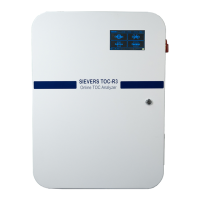SYSTEM DESCRIPTION
Chapter 2
............
Sievers TOC-R3 Operation and Maintenance Manual
DLM 95000-01 EN Rev. A 37 © Veolia 2023
• Required for Plant Instrument Air as Carrier Gas option.
4. Particulate Sampler — Optional pre-treatment system utilizing counterflow filtration
for the removal of solid particles. See “Particulate Sampler” on page 54
.
• Free selectable location within two meters of the Analyzer.
• Assembly uses Metric Standard fittings.
► Connection: DIN 32 Female Slip Fitting(s)
5. ECD Detector — The optional ECD Detector (B2) is a purchasable Feature. This
Detector measures for Nitric Oxide (NO). The Analyzer is only capable of using one
optional Detector at a time. See “B2 — ECD Detector Option (for NO Detection)” on
page 43.
6. PID Detector — The optional PID Detector (B2) is a purchasable Feature. This
Detector measures for POC/VOC. The Analyzer is only capable of using one optional
Detector at a time. See “B2 — PID Detector Option (for POC/VOC Detection)” on
page 44.
THEORY OF OPERATION
TOC Parameter
The Total Organic Carbon (TOC) parameter includes all fractions of organic substances
in water. It can be calculated by measuring Total Carbon (TC) minus Total Inorganic
Carbon (TIC). Non-Purgeable Organic Carbon (NPOC) is a commonly used parameter
which removes volatiles and purgeable organic compounds in a rapid and reliable
method. Where there are no purgeable/volatile compounds, NPOC ~ TOC. TIC includes
carbon dioxide, carbonate, and bicarbonate species often dependent on environmental
conditions.
Purgeable Organic Carbon (POC) or Volatile Organic Carbon (VOC) can cause issues
in industrial processes and remain in a water stream as long as it is conveyed in a closed
apparatus and piping systems. Their analyses often have safety and environmental
reasons. NPOC can then be further classified as Dissolved Organic Carbon (DOC) and
colloids/particulates. DOC is only that amount filtered through 0.45 µm. However both
suspended and dissolved organics can impact water treatment efficiency.

